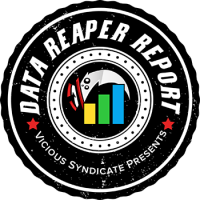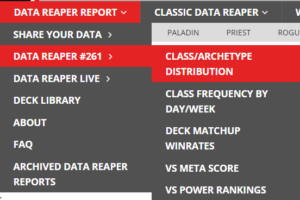
Welcome to the 261st edition of the Data Reaper Report! This is the first report for Festival of Legends and discusses data following the nerfs to Construct Quarter, Lightray and Vengeful Walloper.
Contributing to the Data Reaper project through Hearthstone Deck Tracker or Firestone allows us to perform our analyses and to issue the weekly reports, so we want to wholeheartedly thank our contributors. Without the community’s contributions, there would be no project. Contributing data is very easy, so if you enjoy our content and would like to make sure it remains consistent and free – Sign up!
Quick Links
Class/Archetype Distribution | Class Frequency | Matchup Winrates | vS Power Rankings | vS Meta Score | Class Analysis & Decklists | Meta Breaker of the Week | How to Contribute | Credits
Number of Games
| Overall | 882,000 |
| Top 1K Legend | 28,000 |
| Legend (Excluding Top 1k) | 103,000 |
| Diamond 4 to 1 | 131,000 |
| Diamond 10 to 5 | 180,000 |
| Platinum | 170,000 |
| Bronze/Silver/Gold | 270,000 |
Class/Archetype Distribution
[TABS_PRO id=62164]
Class Frequency
[TABS_PRO id=62165]
Reminder: The graphs in the report are screenshots. You can see all the data, hover over graphs for more information, and select additional bracket filters, in the original tableau files on the website. Clicking on the screenshots in the report, or navigating through the website toolbar, gets you there.

Class Frequency Discussion
The launch of Festival of Legends has been characterized by the significant rise of Death Knight. The nerf to Construct Quarter has not stopped its forward momentum. The class is making a strong case that it is the most powerful one in the format, as it is the only one that has not been affected by rotation. All of its established archetypes have maintained their synergies from the previous year, while adding new ones. Blood-Ctrl DK has been boosted by the reduction of late-game lethality and some meaningful upgrades to its own strategy, rising to become the most popular deck and public enemy #1. Frost-Aggro DK is also very visible, looking like the exact same deck from March of the Lich King and barely running new cards. Unholy-Aggro DK has been more experimental and far less popular than the other two. Rainbow DK experimentation has quickly died out. By the time the early patch arrived, it had largely disappeared from the format.
Demon Hunter had an eventful week. Outcast DH started the expansion strong and looked like the strongest deck in the game after the first day, but the rise of Blood-Ctrl DK has halted its growth. By the time it was nerfed, it was already not particularly popular, so the nerf caused it to decline further. Interestingly, the deck did not continue to decline at higher levels of play, where it has maintained a moderate presence. Relic DH, on the other hand, was non-existent at launch and initially popped up as a response to Blood-Ctrl DK. The deck has been on an upward trajectory since, becoming extremely popular at top legend.
Druid looked dead on arrival at launch before a breakthrough propelled Tony Druid to the forefront of the meta. Tony Druid was the ‘second wave’ response, as it was refined to answer Blood-Ctrl DK and its first responder, Relic DH. Note that ‘late bloomers’ such as Relic DH and Tony Druid are far more popular at top legend since this is where the meta is most advanced in its development. Decks may take some time to trickle down ladder, with the flow of information starting at the top. We still expect to observe continuing disparity between rank brackets as other factors come into play to determine a deck’s popularity.
Rogue started the expansion slow, fooling around with new decks, before top legend players decided that enough was enough. The class is returning to its familiar Miracle Rogue shell, with some adjustments forced by rotation. Secret Rogue is the other noticeable archetype. Everything else within the class hasn’t gained traction. The Combo package from FOL is seeing minimal play.
Paladin was a clear frontrunner at launch, with Pure Paladin delivering a sound beating to other strategies during the first few days. The deck has largely incorporated a divine shield shell, dropping Order in the Court and focusing on early aggression. Its presence continues to be very impactful outside of legend ranks, but there’s a noticeable decline at legend that began before the nerf to Lightray, reminding us that this is, after all, a Paladin deck. Mech Paladin is around at a relatively low play rate, while Big Paladin has mostly disappeared before the patch.
Love Everlasting has encouraged Control Priest exploration at all levels of play, while Undead Priest is tinkering between its two variants. The class seems to be losing interest at top legend over time, where the meta is becoming increasingly concentrated around four classes.
There is waning enthusiasm in Warlock. Chad Warlock saw significant play during the first day but has declined since. Its play rate shrinks dramatically once you hit Diamond 4. Imp Warlock might have it worse, as it is almost completely absent at that rank.
Mage appears lost, fractured into several strategies that haven’t gained much traction. Many players have attempted to make Lightshow Mage work, but its steep decline from day 1 suggests they have failed. Spooky and Mech Mage are the other most notable decks.
Totem Shaman is the sole representative of its class, since Overload Shaman seemed dead on arrival. Hunter is at similar levels of interest, with players mostly exploring Naga builds of Face Hunter, or different variations of Big-Beast Hunter. Warrior is at the bottom of the barrel. Not particularly shocking, but players gave up on this class quickly.
[TABS_PRO id=62166]

[TABS_PRO id=62167]
vS Meta Score
[TABS_PRO id=62168]
vS Power Rankings Discussion
The first snapshot of the expansion shows some clear patterns. The relatively more established, pre-rotation decks appear to be dominating, with Death Knight looking like the best example. Meanwhile, new decks are falling behind. Some of the new decks can improve through refinement and perhaps catch up to the established decks, but others are just largely underpowered and cannot compete. Many of these failed strategies were so weak that they almost completely disappeared before the balance patch and couldn’t even make it to the table. Even if we nerfed some of the power outliers at the top, these failing strategies are unlikely to mount a return without buffs. Let’s dive into the classes to figure out what’s going on.
Death Knight
- It’s easy to understand why Blood-Ctrl DK became public enemy #1. It is both extremely popular and extremely powerful. In fact, after the first couple of days of the expansion, it looked like a Tier S deck: an unstoppable force with no bad matchups. While the deck continues to look very strong throughout most of ladder, dramatic developments at higher levels of play have completely changed the deck’s standing. Players at top legend honed in on the meta tyrant and exploited its late-game weaknesses with great effectiveness. Relic DH and Tony Druid have established themselves as clear counters. Rogue is also showing the potential to frustrate it. Besides Death Knight, those are the three other popular classes at high MMR’s. That’s what the top legend meta has been built around doing.
- While it’s very possible that this development could trickle down the rest of ladder, we don’t have enough information to determine whether players at lower MMR brackets can answer Blood-Ctrl DK with the same kind of effectiveness. Its strength and popularity throughout most of ladder could still be addressed, but it does keep some decks in check that could become too good if it’s given a harsh takedown.
- Frost-Aggro DK is the scarier deck when it comes to pure game balance decisions. Not only is it stronger than Blood-Ctrl DK at every rank bracket, high-level players have not been able to find great solutions for it either. It is much more difficult to target, with its main counter coming from Blood-Ctrl DK.
- And then there’s Unholy-Aggro DK, which has completely flown under the radar but exhibits as much potential to dominate the format as Frost-Aggro DK. It is mostly held back by Frost and Blood, which means that nerfing these two decks too hard could lead to an Unholy explosion. It’s a tricky situation. The one solace is that Death Knight decks are very unlikely to get better. There’s a decent chance that other decks can catch up through refinement, but based on the very first report, it’s hard to tell the extent of that improvement.
Demon Hunter
- Outcast DH is showing surprising resilience. After the nerf to Vengeful Walloper, its win rate took a noticeable dive; yet, over the last few days, it has been recovering. Outcast DH quickly returned to a Tier 1 position at top legend, maintaining a positive win rate throughout ladder and looking very strong against the field, with its struggles mostly coming from Death Knight. Some of it has to do with the rise of Tony Druid (a very good matchup for the Outcast DH), but a high skill ceiling is another major factor. Players got better at piloting this deck very quickly. It is the 2nd most skill-intensive deck in the format after Miracle Rogue, according to our internal analysis.
- Relic DH initially exploded and looked like a Tier 1 deck thanks to its strong matchup against Blood-Ctrl DK, but the rise of Tony Druid has knocked it back a bit. It also struggles against Frost-Aggro DK, so it looks pretty balanced in its matchup spread.
Druid
- Tony Druid has developed into a very effective late-game answer to both Blood-Ctrl DK and Relic DH. Its performance is stronger at top legend for two reasons: (1) It’s a relatively new deck that’s more refined at top legend, and (2) the field is more favorable to it. It greatly struggles against aggressive decks, completely rolling over to strategies like Pure Paladin, so it’s a polarizing deck that’s quite matchup dependent.
Rogue
- Miracle Rogue has found solutions to its rotation problems, spiking in its performance over the last few days and hitting a familiar power level at high MMR. The deck’s main counter is Frost-Aggro DK, which might prevent it from taking the #1 spot but should still keep it close.
- Secret Rogue is another deck that looks competitive and is decently positioned against Blood-Ctrl DK, but its matchups against Demon Hunter are worse, which is why Miracle is superior. Other Rogue decks look pretty bad.
Paladin
- Pure Paladin, much like Blood-Ctrl DK, dominates lower MMR brackets but seems to perform worse at top legend. There is a notable difference in the cause of the fall. While Blood-Ctrl DK has a below-average skill ceiling, much of its struggles at high MMR are a result of being relentlessly targeted by the field. Paladin isn’t being targeted, it just performs significantly worse at higher levels of play in a variety of matchups. In fact, Pure Paladin only seems capable of beating Tony Druid, while rolling over to other established and refined decks. Its fall to Tier 3 at top legend looks inevitable, starkly contrasting its strength elsewhere on ladder.
- Mech Paladin behaves similarly to Pure, but performs worse across all of ladder. Seems hard to justify the choice.
Priest
- While the loss of Voidtouched Attendant stings, other strategies in the format have lost much more, so Undead Priest seems to have come out of rotation very well. Despite its low visibility, it is one of the strongest decks in the format, boasting two viable and competitive variants.
- Control Priest put up a brave fight in its attempts to maintain a competitive win rate, but it all came crashing down after the rise of Relic DH and Tony Druid. These decks’ goals were to target Blood-Ctrl DK, but the collateral damage hit the other attrition deck. Control Priest looks bad throughout ladder due to lack of refinement and difficulty in piloting it. Ironically, it looks at its worst at the hands of the best players running the most refined builds, because the top legend field is horrible for Control Priest.
Warlock
- On the surface, the class looks unplayable. Chad Warlock has crumbled under the pressure of the best decks. We did find a way for it to compete better against late-game strategies such as Tony Druid, Blood-Ctrl DK, and Relic DH, so its late-game outlook is not as bad as the stats suggest. Regardless, the deck is extremely vulnerable to aggression.
- Imp Warlock’s prospects look grim in the current format. The fatigue package isn’t bad, but the deck simply cannot compete. It has no scope for improvement either.
Mage
- Mage is generally a mess. Lightshow is a complete meme. Mech Mage is not good at its best, while falling off completely against a ruthless field. Spooky Mage shows some competitive potential once it’s refined. An aggressive shell might have a ceiling of mediocrity, but a Cosmic Keyboard shell is the class’ best hope for a serious contender. It’s worth some further testing.
Hunter
- Face Hunter is showing decent competitive potential on ladder, with a high scope for improvement. Unlike in many past expansions, this archetype is not close to being figured out early and there’s a lot that hasn’t been optimized. The build in this report is experimental in an attempt to gain more clarity on what works. In fact, this archetype might be trending to be much more late-game focused, to the point it may not be a “Face” Hunter deck anymore. If Hunter figures out how to package a strong late game inside an early-game-focused shell, it could be a serious contender.
- Big-Beast Hunter is bad when it fully embraces being a Big-Beast Hunter and looks better when it tries to imitate Face Hunter and goes “hybrid” Renathal. This might be because Face Hunter is just better, and BB Hunter is a poor imitation. Alternatively, it could find its own place in the meta. It’s very early to say. The lack of attention on the Hunter class should delay a clear answer to the next report.
Shaman
- Shaman is a bit of a sleeper. Totem Shaman is quite strong and has great scope for improvement once it’s optimized for the current format. It’s likely one of the best decks to climb to legend with that’s not a Death Knight deck. It’s still possibly a bit limited at higher levels of play, but you’re looking at a Tier 2 at top legend and a Tier 1 deck everywhere else on ladder if you gave it a week in its current trajectory.
- Overload Shaman? You can nerf the entire Tier 1 bracket, and this stuff is not going to become playable.
Warrior
- Control Warrior is absolutely terrible. Tony builds have win rates in the 20’s. If you go for Blackrock ‘n’ Roll, you might hit a 40% win rate. Menagerie Warrior looks very far away from being competitive too. It’s grim for these decks.
- But Warrior is not that far away from being competitive if you count on an Enrage shell, which is a deck that players seem to ignore very often. This archetype can even incorporate a Blackrock ‘n’ Roll package and hit Tier 3. It could also just go for pure aggression, which is something we’re not seeing enough. It could still be underwhelming, but it’s possible that players have given up on the class a bit too quickly.
Class Analysis & Decklists
Death Knight | Demon Hunter | Druid | Hunter | Mage | Paladin | Priest | Rogue | Shaman | Warlock | Warrior
The Blood-Ctrl Death Knight build we recommend is the one we featured in our theorycrafting article, with one change. Construct Quarter was the worst card in the deck even before its nerf, so it was going to be a candidate to be cut from the deck regardless of the change. With the nerf in place, it becomes an obvious cut. Amalgam of the Deep provides more discover power to the deck. Fizzle is a popular inclusion but don’t fall for it. It looks terrible. Dirty Rat is another popular choice meant to answer some of Blood DK’s counters, but the card has proven to be a liability, so far.
Frost-Aggro Death Knight has tinkered with very few new cards in its build. Hardcore Cultist is the most popular addition, but it looks like the worst card in the deck. Rowdy Fan has stepped up as a strong replacement for Construct Quarter.
One card we’re getting preliminary data on is Pozzik. The 4-drop legendary looks nuts, so we’d like to see more data on the card to confirm our suspicions. The deck tends to be corpse starved, so it’s okay to drop one Might of Menethil or even Marrow Manipulator for Pozzik. Another small change is adding Astalor for one Harbinger of Winter. It gives you more late game to beat Blood-Ctrl DK, the deck’s most difficult matchup, relatively speaking.
Unholy-Aggro Death Knight has been the most difficult deck to figure out, as it’s seen a lot of experimentation. The WuLing build is the best one we’ve seen by far, potentially challenging Frost-Aggro’s dominance at the top of the meta. It runs no eggs and no Death Growl. Just regular minions hitting face with the help of Rowdy Fan. Astalor gives you more late game vs Blood-Ctrl.
Outcast DH has been able to outlast a quick nerf to Vengeful Walloper. It still looks like one of the stronger decks in the format. We’ve found no reason to change any cards from the build featured in the theorycrafting article. Rowdy Fan is the worst card in the deck but is an essential piece in the difficult Blood-Ctrl DK matchup, thanks to the S’theno combo. Therefore, cutting it doesn’t seem to be beneficial.
Relic DH has proven to be a reliable counter to Blood-Ctrl DK and the name of the game for its optimal build appears to be greed. Immolation Aura looks quite weak and unnecessary in a format that doesn’t feature many decks that flood the board, since they get punished by the dominance of Blood and Frost Death Knights. This could change in the future, so we’ll pay close attention to it.
To counter Blood-Ctrl DK harder and have a better chance in the rising Tony Druid matchup, Relic DH is pivoting to the most powerful late game it can afford. Astalor and Xhilag aren’t too popular now, but they appear to be important pieces based on their performance.
Fizzle is a card that looks terrible in any other deck and looked like a clear trap card in DH early in the expansion. As it currently stands, it is the borderline 30th best card in the deck. It’s barely good enough because of its synergy with the Relic package and it’s very likely the first card we will cut the moment we find something better. It is good news for Fizzle fans though – you can play it in Relic DH without getting severely punished for it.
Tony Druid’s fortunes changed the moment it introduced Mish-Mash Mosher in combination with Attorney-at-Maw. We’ve previously noted that Mosher had potential in a Jailer deck because of its ability to clear a huge board with immunity. The availability of Attorney-at-Maw in Druid, granting immunity to Mosh pre-Jailer, turns it into a serious competitive option.
The featured build looks clean and has the potential to be a Tier 2 deck. Astalor is quite important for Druid’s late game, as it is in many other decks. To make way for it, we advocate running one Innervate. This means that Seedsman is more likely to find us Nourish, which is important for allowing us to ramp into Jailer/Anub. A single copy of Innervate can still help us play one of our big bombs a turn earlier.
Reminder of the Jailer/Tony order. Against decks that have no ability to clear immune boards, you play Jailer first and then Tony. Against decks with the ability to clear immune boards (Blood-Ctrl DK, Control Priest etc.), you play Tony first and then Jailer. In the latter case, Anub’Rekhan is essential to play Tony/Jailer in the same turn.
Miracle Rogue looks very strong at higher levels of play, with order being quickly restored. The adjustments it ended up making are interesting. There’s no combo package, as it looks terrible. There is no Draka, as attempts to fuel Draka with an alternative to Mailbox Dancer haven’t panned out. Instead, we run Azshara as a secondary win condition and Crabatoa.
What’s scary is that Miracle Rogue currently looks outstanding despite running three suboptimal cards. Hipster was meant to improve the performance against Blood-Ctrl DK by exploiting its discover pool, but the card looks horrendous in most other matchups.
Meanwhile, Fizzle looks remarkably bad. Unlike in Relic DH, it looks extremely far off from being a legitimate option in Miracle Rogue. Contrary to anecdotal suggestions, the card doesn’t even help you beat Blood-Ctrl DK more often. It doesn’t look better at higher levels of play either. We’ve tried to find any lead, any avenue, any reason, any excuse, to try justifying the card. We couldn’t make sense of the madness. It simply looks unequivocally garbage.
Alternatives haven’t been popular, so we encourage exploration here. Our vanilla suggestion is to run Bloodmage Thalnos and Gone Fishin’. Neither of these cards are amazing, but Thalnos is very good with the new 2-mana Fan of Knives while Gone Fishin’ has been a successful inclusion in the deck before and doesn’t seem terrible now.
Secret Rogue is viable, though inferior to Miracle. The best secrets in the secret package seem to be the ones that impact the board, so Ambush and Sticky Situation are preferred over Cheat Death and Double Cross. Tess Greymane doesn’t seem great.
Pirate Rogue looks weak. Air Guitarist seems to be a decent fit next to Swordfish and the weapon buff package, but the deck has a terrible time dealing with Death Knights.
Pure Paladin has started strong. It’s demolishing bad decks and inexperienced players but might hit its inevitable wall at higher levels of play.
The best and most popular build has been focused on divine shields, running many cards we’ve foolishly and incorrectly underestimated. We’ve been flirting with the idea of adding Order in the Court to the deck, but it doesn’t seem to be particularly beneficial in the current meta.
Mech Paladin seems playable and good enough, though inferior to Pure. There is one adjustment from the theorycrafted build: Grimestreet Outfitter in, Annoy-o-Tron out.
Undead Priest looks like one of the strongest decks in the format and the theorycrafted Burn variant looks optimized, but the Swarm variant looks like a very competitive alternative and is possibly stronger. The Burn variant does better into Death Knights (Blood/Frost), while the Swarm variant is superior against Tony Druid and Relic Demon Hunter.
Control Priest has been struggling to deal with several developing Blood DK counters that have inadvertently destroyed its competitive prospects in the current meta. In its desperation, Priest is utilizing Dirty Rat. Rat has looked very bad early in the expansion but following a steep rise in Tony Druid and Relic DH, Rat is making more sense.
The issue is that if you’re queueing into a format that justifies Rat’s inclusion (abundance of DH/Druid), you should probably not be playing Control Priest.
The best build is inspired by TicTac’s initial iteration of the deck. Nerubian Vizier is a Vulpera Scoundrel with one more health, as you will rarely activate it, but we’ve found that Priest is desperate for any sort of turn 3 play. Astalor is very important for Control Priest now because it’s a strong closer in combination with Power Chord: Synchronize. Fizzle is disastrously bad in Control Priest because you often don’t even have space in hand to open the snapshot! The extra value Fizzle provides is completely redundant with Sister Svalna.
Chad Warlock has been an early disappointment this expansion, but new developments could still put a small dot of it on the map. A recent build has appeared running Shallow Grave and Habeas Corpses. These two cards provide the necessary greed alongside Cover Artist to compete with other late game powerhouses. Hellfire and Felstring Harp are the cuts, as AOE and sustain are not too important in the format.
Mage started this expansion in a disastrous fashion. All iterations of Lightshow Mage are some of the worst decks you can possibly play. Manastorm Mage has bombed.
But some Mage decks are showing competitive potential. The aggressive Spooky Mage build we featured in the theorycrafting article looks respectable. Another iteration runs Cosmic Keyboard and is more late-game oriented. It seems to be missing a proper win condition, so we’ve added Vexallus and Arcane Bolts to give it stronger inevitability. This is the most promising Mage deck we’ve found, but we’d like to see more data on it and the performance of the Vexallus package.
We’ll obviously split these variants apart if they both become popular, but it was pointless for this report.
Mech Mage is also around, but just isn’t very good. The list from the theorycrafting article looks alright for a Mech Mage.
Hunter doesn’t appreciate the Death Knight dominance and is attempting to find solutions. Face Hunter hasn’t reached a refined form, with players experimenting with numerous builds. In a competition between Jungle Jammer and Hope of Quel’Thalas, we’re beginning to lean to the latter, alongside a robust mid-to-late game that starts at School Teacher/Pozzik and ends at Collateral Damage.
Queen Azshara and Ancient Krakenbane are two cards that exhibit great promise with Bananas and Monkeys. Mister Mukla is underplayed but looks powerful in the archetype. The Naga tribe is strong, but some of the Naga payoffs, such as Barbed Nets and Naga’s Pride, just don’t seem very worthwhile.
This build merges a few builds together, taking the best parts and trying to come up with an optimal list. It’s likely we’ll need a second pass to optimize the deck further. What we’re sensing from Hunter as well as other classes, is a sheer desperation to run the most robust late game possible. This build basically makes no compromises and runs all the strong win conditions. We’ll see if these cards end up stepping on each other’s toes and suffer from diminishing returns after we get more data.
Big-Beast Hunter looks very bad when it runs a big package of late game threats and Big Dreams. It seems to do better running a Hybrid build that imitates a lot of Face Hunter’s early game while minimizing its big beast package. We’re not convinced this deck can compete with an optimized Face Hunter list though.
Overload Shaman is a complete failure. Shaman does have a competitive deck in Totem Shaman, but that’s it. The featured Totem build makes big adjustments to compete better vs Blood-Ctrl DK. Famished Fool replaces Gorloc Ravager since Clownfish looks quite weak. Ancestral Knowledge would normally never be considered in this kind of deck, but having fuel means everything in the current meta. ‘JIVE, INSECT!’ doesn’t offer the reach that Bloodlust does and is too easily dealt with by Asphyxiate.
Warrior looked terrible. Tony & Blackrock Control Warrior are completely unplayable. Menagerie Mech Warrior doesn’t show any competitive potential. It looked like the class was headed for another expansion of irrelevance.
But there’s a little bit of hope. An Enrage Warrior build running Blackrock ‘N’ Roll is showing some promise. The ability to activate Grom Hellscream with Sanguine Depths, potentially buffed by the legendary spell, makes the card a very strong finisher in the deck. Blackrock ‘N’ Roll is a Fire spell, so a turn 4 Thori’belore prevents it from being an empty turn since it can revive the bird. Anima Extractor can be utilized with Sunfury Champion to further buff minions in your hand, making you less reliant on finding the legendary spell to produce intimidating late game threats.
Furthermore, Enrage Warrior has many card draw options to find its threats. Acolyte of Pain, Roaring Applause and Light of the Phoenix can all be quite efficient in this deck.
Currently, the archetype is exhibiting a Tier 3 performance level, but perhaps other players can take this build and improve it further. It’s unlikely to be optimal. We’re also curious about more aggressive, low curve Enrage builds, but they’re likely getting scared away by Blood-Ctrl DK.

The most dangerous deck in the current format is, without a doubt, Frost-Aggro DK. Unlike its Blood counterpart, even the smartest and most experienced players have not been able to find a reliable answer for it. Its matchup spread looks extremely resilient, making it a strong nerf candidate next week. Considering the internal checks between the Death Knight archetypes, it’s going to be quite tricky to address them in a way that’s impactful, but without unwanted side effects.
It also becomes clear why Death Knight had a weak MLK launch, as Team 5 had to juggle its ability to compete in a 6-set format without dominating a 4-set format months after.
Alongside some major buffs hinted to come, we’re hoping to try more of the cool stuff that Festival of Legends has brought to the table. Abuse this deck while you can for an easy climb, but don’t expect it to last very long.
Preparing our weekly article requires a significant amount of time and effort from many individuals. We would like to wholeheartedly thank our current Patreons, whose generous donations help us fund computing and server costs.
vS Gold is our membership plan aimed to support our efforts towards improving our content and data analysis while receiving some bonuses and extra features.
Tier 3+ Patrons
Special thanks to Leo, Jed M, Drew M, Alan J, Zolstar, Sean H, Steve F, Andrew N, Alonso P, Je-ho, William H, 1RiceBowl1, Alex S, PeejTreon, Josh G, Amir, Matthew P, amenbrotep, Karhu, Christopher N, Eric F, Lime, Kaushal, Joshua B, Jeff C, Scott L, Mark P, The Big Dawg, nburst, Jess M, Peter, Lepton, Bob L, Charlah R, Chocobo, Chad K, Alex W, Ashton F, Ethan G, Potato, Swift, Logan, Fisherington, Michael H, WorldEight, Jacob M, Joseph G, Kristopher S, Timothy M, Dylan X, Darren J, Wyatt P, and Nick M for supporting us this month.
Here are all the people that participated in bringing you this edition of the vS Data Reaper Report:






















Dancing Paladin is 100% one of the strongest decks in the format. Lists need to drop Holy Maki Roll, it’s far and away the worst card in your deck, and replace it with Harmonic Disco. Card is super underrated and really helps shore up the decks awkward mid game if you don’t draw Kangor, without jeopardizing your synergies. Also, Neptulon is terrible. Drop him, add a 1-of Mish-Mash Mosher to help give your Flesh Behemoth redundancy, and give you a way to reliably clear the board off of Front Lines. Combine that with the fact that he comes down naturally 2 turns earlier than Neptulon AND has beter synergy with Kangor, and it’s a no brainer. The deck beats Blood DK for borderline free with Rivendare, and Frost DK can’t pressure you enough before you take over the game. You’re faster than Tony Druid, and go bigger than Relic DH, so really the only bad matchups are decks that can get under you before turn 5-6, which are decks that are all but disappearing in high legend. But even VS those decks, you have the tools to fight for the early game with Feast and Famine, Consecration and Muster for Battle. In a meta-game where everything is looking to be as greedy as possible, Paladin is incredibly well positioned with one of the most potent mana-cheating strategies available, with several unique win-conditions outside of that strategy.
It’s not bad but definitely not strong enough either. BDK and Priest can easily counter you with silence. Druid can make you over drawing or just bring a Rivendare himself. Any other aggro decks can easily beat (2 in 3 games) you and you will be struggle to survive past turn 7. Yes you have some tools but it’s too hard to get a stable perfect draw to counter both beginning and late game. You are either too slow or lack of finishing cards. The deck is not in the meta for a reason.
BDK doesn’t run Silence effects, basically ever. Nor does Druid run Rivendare, and thinking that overdrawing cards is at all relevant out of niche matchups is… definitely a take. So I have no idea what you’re referencing there, but Priest is also less than 5% of the meta, so less than 1 in 20 games will you ever see them. The only other aggro decks that consistently beats you is Pure Paladin, also it makes up only 5% of the meta as well. Dancing paladin is a meta call, because it has winning match-ups vs DK, Druid, and DH. All of which are far and away the most played classes at Legend rank. The deck having bad matchups means almost nothing when those bad matchups make only 10% of what people are playing at your rank, and it’s winning matchups make up 75% of your actual games. Is it the best deck to climb with? Of course not, but at high legend it has winning match-ups across the board. The deck is extremely sensitive to card choice, meaning that unrefined builds get absolutely blown out, which I’m pretty sure is why people have poor opinions of the archetype, but I all but guarantee that’ll change eventually